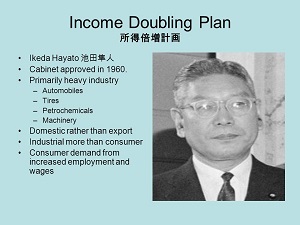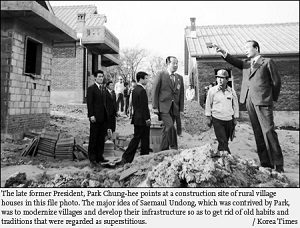Japan, South Korea and Singapore took different approaches to overcome the middle-income trap and successfully fostered a stable middle class to form a rugby-shaped society in terms of income.
 Japan: Income-Doubling Plan
Japan: Income-Doubling Plan
In December 1960, when then Japanese Prime Minister Hayato Ikeda proposed the ambitious “income-doubling plan” aiming at doubling average per capita incomes in 10 years, all people thought it was mission impossible.
Starting from 1961, the Japanese government took a series of measures to increase people’s income. In agriculture, the government raised the price of farm products and encouraged production efficiency. In industry, the government cut taxes and lowered interest rates to facilitate borrowing and reduce costs. In commerce, the authority pushed trade liberalization and narrowed the salary gap.
The Ikeda government also heavily invested in infrastructure, communications and technology innovation. It also worked to balance urban and rural development.
The 1960s was called the “Golden Sixties” of Japan. The economy rose from the ashes of World War II — the gross national product doubled in only six years, and average per capita income doubled in seven years.
The results of the income-doubling plan were fast economic growth, increased average income and rebalanced social wealth with the emergency of a middle class of 100 million people.
 South Korea: New Village Movement
South Korea: New Village Movement
Before 1970, the disparity in living standards between South Korea’s urban and rural areas was serious.
Then President Park Chung-hee launched the New Village Movement in 1970 to rectify the growing disparity. Diligence, self-help and collaboration were the slogans to encourage community members to participate in the development process.
The early stage of the movement focused on improving the basic living conditions and environment. Later projects concentrated on building rural infrastructure and increasing community income.
Encouraged by the success in rural areas, the movement spread through factories and urban areas as well, and became a nationwide modernization movement.
Thanks to the decades-long movement, the income of South Korean farmers increased significantly, even surpassing that of city dwellers.
In the 1990s, South Korea’s urbanization rate had reached above 70 percent, the rural population had dropped from 80 percent of the total population to less than 10 percent.
Besides the New Village Movement, the South Korean government had also paid extra care to low-income people and under-privileged groups, weaving a social safety net to reduce absolute poverty.
 Singapore: Talents Program
Singapore: Talents Program
From the 1980s on, Singapore began to cultivate a majority middle-class society. A key factor of success is education, also called “the talents program.”
The Singaporean government takes education as an investment to its people, thus putting a lot of emphasis on the development of education and human resources.
Statistics show that education funds account for at least 12 percent of the annual state budget, and can be as high as 35 percent, the second-highest in the government’s yearly expenditure.
Primary, secondary and tertiary education is mostly supported by the state. The government puts equal emphasis on basic education, advanced education and vocational training. It also encourages the students’ creative and critical thinking, and allows autonomous schools to outline their own curriculum.
Through higher education and vocational training, Singaporeans become more skillful and professional, their job opportunities and income increase subsequently. These people have gradually become the hardcore of the society’s middle class.
The Singaporean government also offers preferential policies and good treatment to attract foreign professionals to work and live in Singapore. Together domestic and overseas professionals continuously contribute their wisdom and skills to Singapore’s economy.
Looking at how the three East Asian countries foster their middle classes, it’s not hard to find that although with different emphases, the paths are similar. That is, to promote economic development through various measures including education, trade, investment and innovation, in a bid to increase people’s income, and to rebalance social wealth by narrowing the gap between the rich and the poor.
With the support of a stable and mainstream middle class, the three countries successfully advanced to high-income societies. by Fei Liena, Zhang Dailei/Enditem (Cihan/Xinhua)


